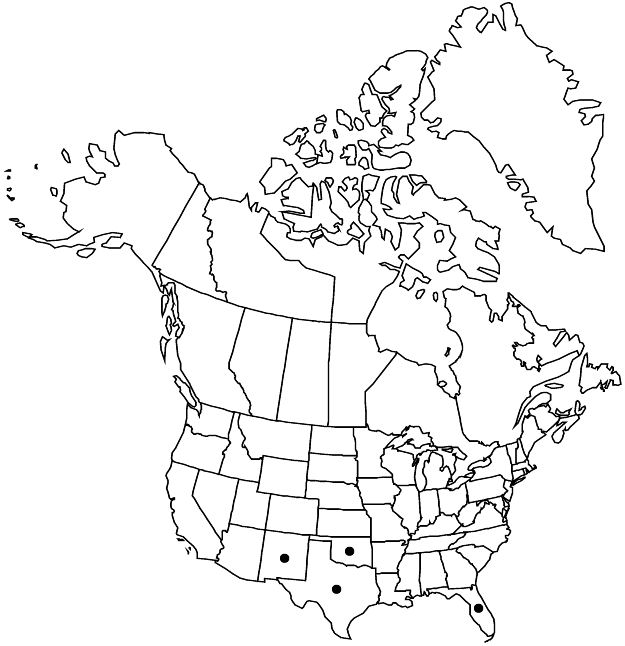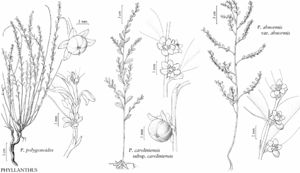Difference between revisions of "Phyllanthus abnormis var. abnormis"
FNA>Volume Importer |
FNA>Volume Importer |
||
| Line 27: | Line 27: | ||
|elevation=0–1200 m. | |elevation=0–1200 m. | ||
|distribution=Fla.;N.Mex.;Okla.;Tex.;Mexico (Tamaulipas). | |distribution=Fla.;N.Mex.;Okla.;Tex.;Mexico (Tamaulipas). | ||
| − | |discussion=<p>Variety abnormis is disjunct between peninsular Florida and Texas, southwestern Oklahoma, southeastern New Mexico, and northern Tamaulipas. The Florida plants generally have three stamens in one of the two staminate flowers in the proximal cymules; both flowers have only two stamens in the western plants. The stems are consistently smooth in Florida, southern Texas, and Tamaulipas, but usually moderately to densely scabridulous elsewhere. The hypothesis by G. L. Webster (1970) that plants of var. abnormis with scabridulous stems show introgression from var. riograndensis is unlikely because populations of var. abnormis growing closest to var. riograndensis have smooth stems.</p> | + | |discussion=<p>Variety abnormis is disjunct between peninsular Florida and Texas, southwestern Oklahoma, southeastern New Mexico, and northern Tamaulipas. The Florida plants generally have three stamens in one of the two staminate flowers in the proximal cymules; both flowers have only two stamens in the western plants. The stems are consistently smooth in Florida, southern Texas, and Tamaulipas, but usually moderately to densely scabridulous elsewhere. The hypothesis by G. L. Webster (1970) that plants of <i></i>var.<i> abnormis</i> with scabridulous stems show introgression from <i></i>var.<i> riograndensis</i> is unlikely because populations of <i></i>var.<i> abnormis</i> growing closest to <i></i>var.<i> riograndensis</i> have smooth stems.</p> |
|tables= | |tables= | ||
|references= | |references= | ||
| Line 51: | Line 51: | ||
|publication year= | |publication year= | ||
|special status=Selected by author to be illustrated | |special status=Selected by author to be illustrated | ||
| − | |source xml=https://jpend@bitbucket.org/aafc-mbb/fna-data-curation.git/src/ | + | |source xml=https://jpend@bitbucket.org/aafc-mbb/fna-data-curation.git/src/8f726806613d60c220dc4493de13607dd3150896/coarse_grained_fna_xml/V12/V12_435.xml |
|genus=Phyllanthus | |genus=Phyllanthus | ||
|species=Phyllanthus abnormis | |species=Phyllanthus abnormis | ||
Revision as of 14:46, 18 September 2019
Stems glabrous to densely scabridulous. Leaf blades glabrous on both surfaces or sparsely to moderately scabridulous abaxially. Bisexual cymules with 1 staminate flower. Pistillate nectary glands strongly unequal, spatulate, as long as or longer than broad.
Phenology: Flowering and fruiting spring–fall (year-round in Florida).
Habitat: Open oak woodlands, prairies, barrens, dunes, always on sand.
Elevation: 0–1200 m.
Distribution

Fla., N.Mex., Okla., Tex., Mexico (Tamaulipas).
Discussion
Variety abnormis is disjunct between peninsular Florida and Texas, southwestern Oklahoma, southeastern New Mexico, and northern Tamaulipas. The Florida plants generally have three stamens in one of the two staminate flowers in the proximal cymules; both flowers have only two stamens in the western plants. The stems are consistently smooth in Florida, southern Texas, and Tamaulipas, but usually moderately to densely scabridulous elsewhere. The hypothesis by G. L. Webster (1970) that plants of var. abnormis with scabridulous stems show introgression from var. riograndensis is unlikely because populations of var. abnormis growing closest to var. riograndensis have smooth stems.
Selected References
None.
